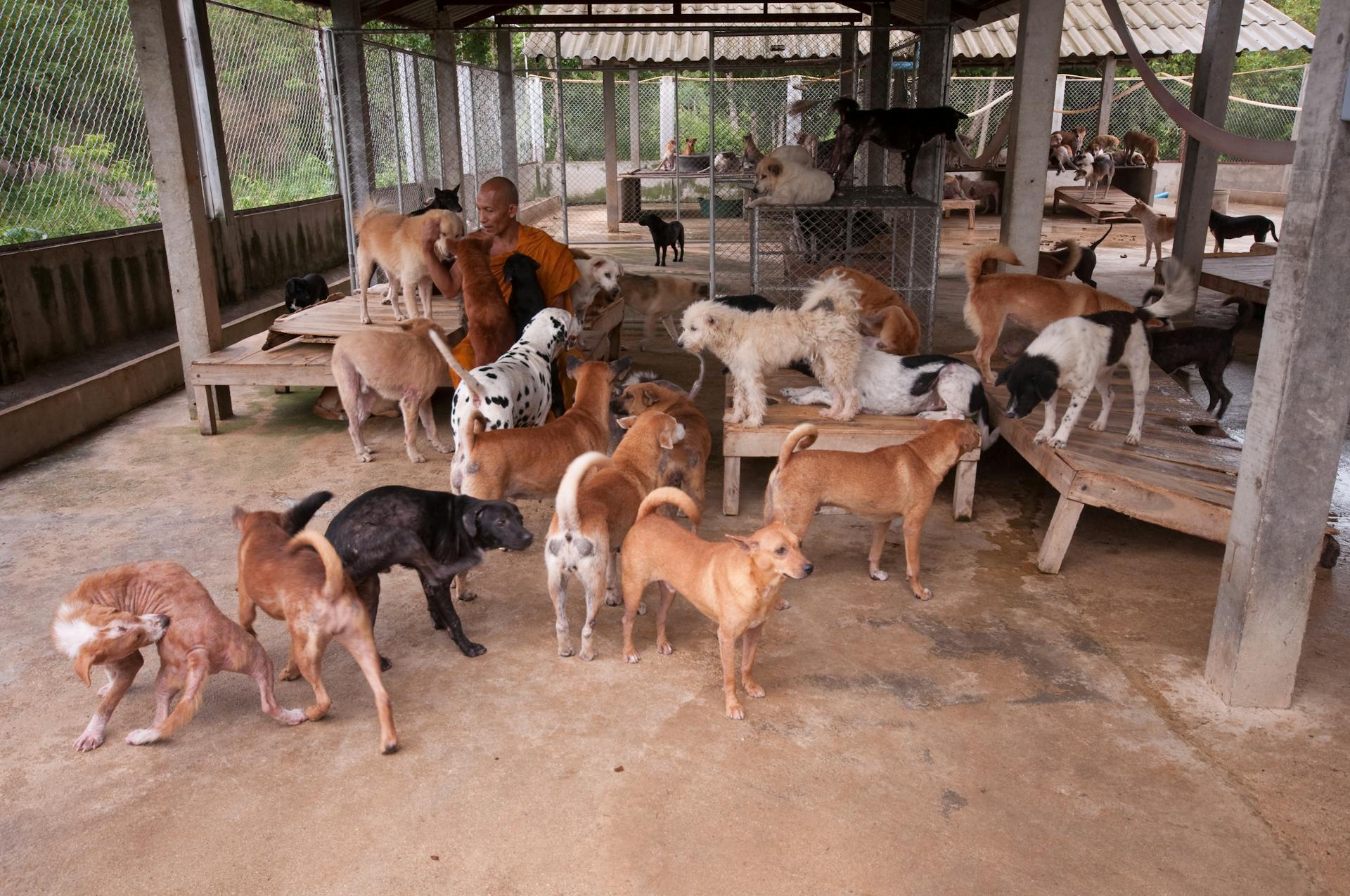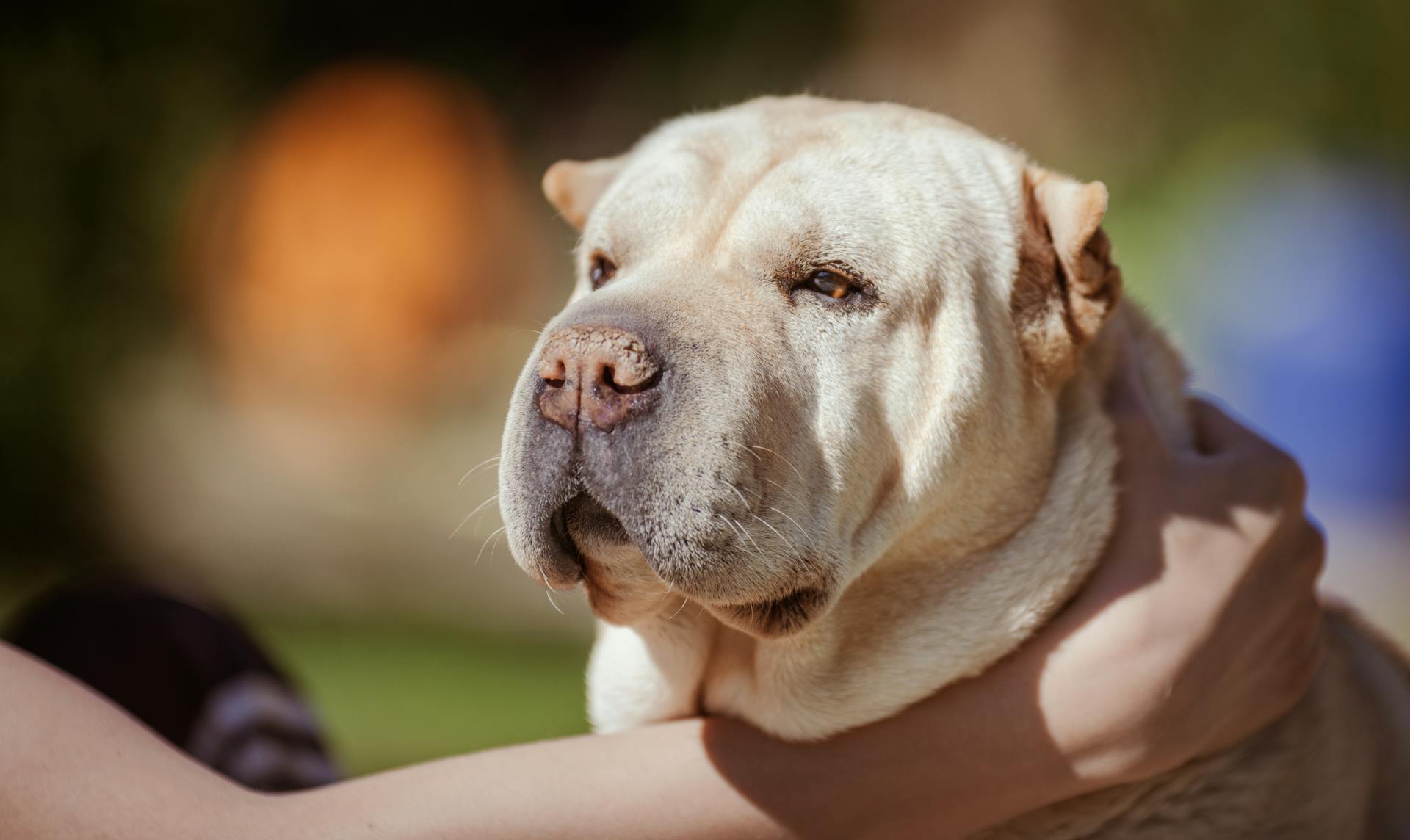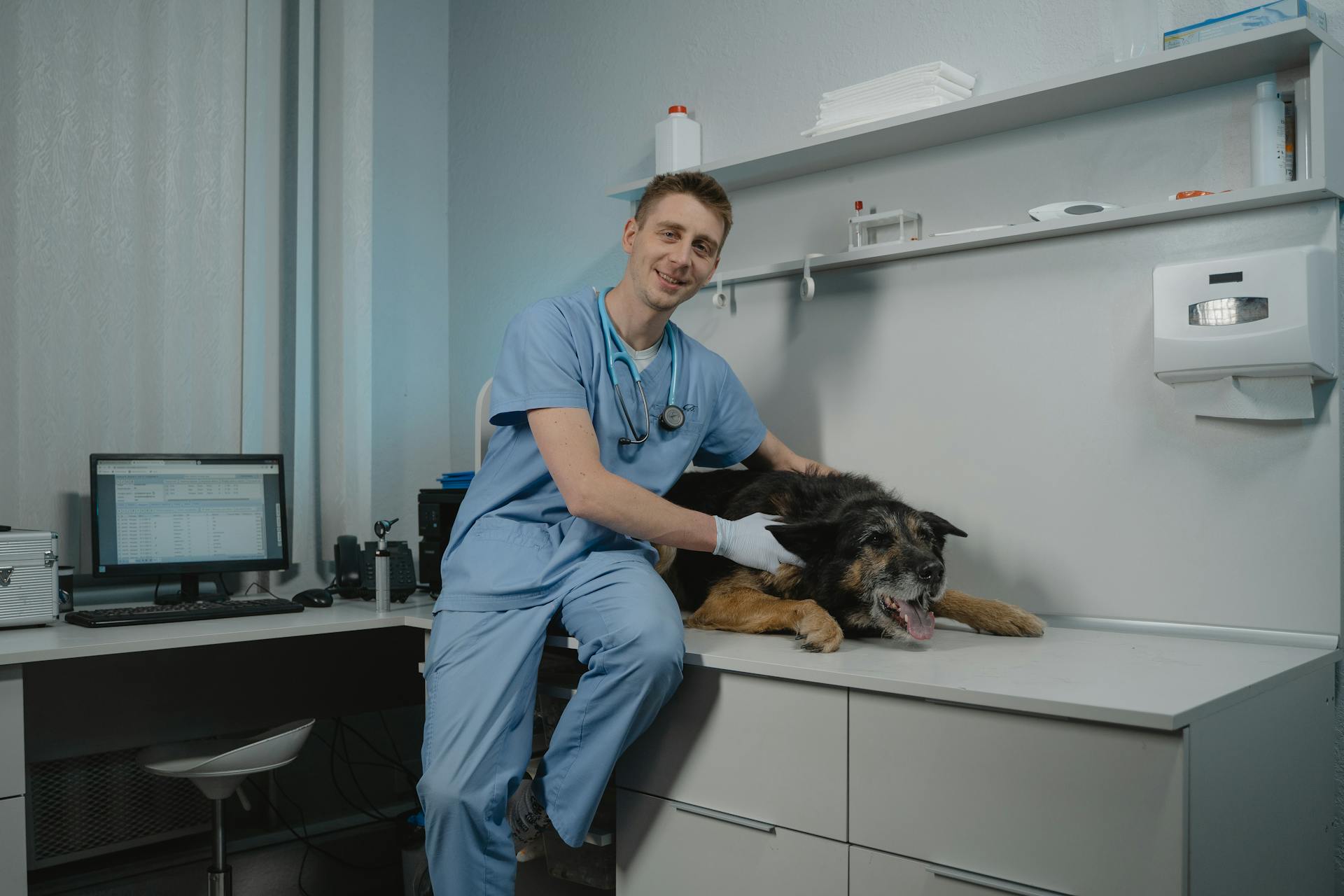
Airborne dog diseases can be a serious concern for dog owners. They can cause a range of symptoms, from mild respiratory issues to life-threatening conditions.
Some airborne dog diseases are highly contagious and can spread quickly among dogs in close proximity. Kennel cough is a classic example, caused by the bacteria Bordetella bronchiseptica.
Dogs can contract airborne diseases through inhalation of infected particles, which can be present in the air for a surprisingly long time. For instance, the virus that causes canine influenza can survive on surfaces for up to 24 hours.
Preventing airborne dog diseases often requires a combination of vaccination, regular cleaning, and social distancing measures. This is especially important for dogs that interact with other dogs frequently, such as those in dog daycare or kennel settings.
Causes and Spread
Airborne dog diseases can be a real concern for pet owners, and understanding how they spread is key to keeping your furry friends safe. Canine distemper is one such disease that's highly contagious and can be spread through the air.
Puppies and dogs often become infected through airborne exposure to the virus from an infected dog or wild animal, which can happen through sneezing, coughing, or barking. This is a crucial reminder to keep an eye on your pup's behavior and health.
Infected dogs can shed the virus in body fluids like respiratory droplets, saliva, or urine, and may be contagious for several months. This means that even if your dog seems fine, they can still be spreading the disease to others.
Shared food and water bowls and other items can also be a breeding ground for the virus, so make sure to clean and disinfect them regularly. I've seen firsthand how quickly germs can spread in a household, so it's essential to be proactive.
Infected mother dogs can pass the virus to their unborn puppies, which is why vaccination is so important, especially for pregnant dogs. This is a harsh reality, but it's a reminder of the importance of responsible pet ownership.
Contact between wild animals and dogs can cause the disease to spread, which is why outbreaks in local wildlife populations can increase the risk of infection for pet dogs in the area.
Check this out: Why Dogs Attack Other Dogs
Distemper
Distemper is a serious airborne dog disease that can be diagnosed through a combination of clinical signs and laboratory testing.
Veterinarians often look for symptoms such as vomiting, diarrhea, and neurologic signs to determine if a dog has distemper.
Unfortunately, there is no cure for canine distemper and no antiviral drugs have been approved to combat the infection.
Supportive care, like fluids to correct dehydration and medications to prevent secondary infections, is usually the treatment approach.
For more insights, see: Best Food for Dogs with No Teeth
Background and Investigation
In December 2023, the USDA stated that genetic testing showed common causes of canine infectious respiratory disease in the cases it investigated.
Veterinarians and specialists from various institutions have been working together to get to the bottom of these cases.
The Oregon Veterinary Diagnostic Laboratory (OVDL) and the USDA's National Veterinary Services Laboratory (USDA-NVSL) are among the organizations involved in the investigation.
The University of New Hampshire Veterinary Diagnostic lab reported that it found a potential novel bacterial respiratory pathogen in 14% (31/226) of the samples they tested in January 2024.
This data is still preliminary and should not change how veterinarians treat respiratory illness cases.
Background

In August 2023, the Oregon Department of Agriculture (ODA) received reports of an atypical canine infectious respiratory illness being seen in dogs in the Portland Metro and Willamette Valley areas.
Over 200 reports of atypical canine infectious respiratory disease were received by ODA from Oregon veterinarians as of their last public update.
Some of these reports were about illnesses that occurred earlier in the summer of 2023, prior to August.
Veterinarians in other states, such as New Hampshire, have reported similar canine illnesses as far back as summer 2022.
Readers also liked: National Dog Show 2023 Dogs
Investigation
The investigation into the canine infectious respiratory disease has been a collaborative effort among several top-notch institutions.
ODA has worked closely with reporting veterinarians and specialists at the Oregon Veterinary Diagnostic Laboratory (OVDL) and the USDA's National Veterinary Services Laboratory (USDA-NVSL).
Genetic testing by the USDA in December 2023 revealed common causes of canine infectious respiratory disease in the cases they investigated.
The University of New Hampshire Veterinary Diagnostic lab found a potential novel bacterial respiratory pathogen in 14% of the samples they tested, which is 31 out of 226 samples.
The University of New Hampshire report emphasizes that the data is preliminary and should not change how veterinarians treat respiratory illness cases.
Precautions and Prevention
To minimize the risk of airborne dog diseases, it's essential to take precautions and follow prevention methods.
Regularly wash your hands after interacting with your dog, especially after activities like walking or playing, as this can help prevent the spread of diseases like kennel cough.
Make sure your dog is up-to-date on all vaccinations, as this can significantly reduce the risk of airborne diseases.
Avoid close contact with dogs that are showing symptoms of illness, such as coughing or sneezing, to prevent the spread of diseases like canine influenza.
Keep your dog away from areas where other dogs have been, as airborne diseases can linger in the air for extended periods.
Regularly clean and disinfect surfaces and objects that your dog comes into contact with, as this can help reduce the spread of airborne diseases.
If your dog is diagnosed with an airborne disease, isolate them from other dogs and follow the recommended treatment plan to prevent the spread of the disease.
For Dog Owners
As a dog owner, it's essential to take proactive steps to protect your furry friend from airborne dog diseases. Vaccinate your dog as recommended by your veterinarian, which may include vaccinations for canine influenza, Bordetella, parainfluenza, and canine adenovirus type 2.
To minimize the risk of infection, avoid communal water bowls and toys, and clean these items thoroughly. This simple habit can go a long way in preventing the spread of disease.
If you're planning to socialize your dog, consider creating a playgroup with known dogs that are also vaccinated. This way, you can ensure your dog is interacting with healthy, disease-free companions.
For Dog Owners
As a dog owner, you want to keep your furry friend healthy and happy. Vaccinate your dog as recommended by your veterinarian, which may include shots for canine influenza, Bordetella, parainfluenza, and canine adenovirus type 2.
To prevent the spread of diseases, avoid communal water bowls and toys, and make sure to clean them thoroughly. I've seen firsthand how easily germs can spread through contaminated water and toys.

Socialization is crucial for dogs, but it's also essential to be cautious. Avoid playdates with unknown dogs, and consider creating a playgroup with known dogs that are also vaccinated. This way, you can ensure your dog is interacting with healthy and well-cared-for animals.
If you're planning to take your dog to an off-leash dog park, be aware that it's a high-risk area for disease transmission. Limit your dog's exposure to such settings or avoid them altogether if possible.
If your dog gets sick, keep them at home and seek veterinary care right away. Don't hesitate to get PCR testing to determine the cause of the illness.
Dog Owner Speaks Out About Mystery Illness
Dog owners have been facing a mystery illness affecting their pets.
Some dogs have started showing symptoms in November.
Wendy Brown's three golden retrievers, Bridge, Dooley, and Lulu, are among the affected dogs.
Dooley started exhibiting symptoms first, with a huffing sound and lethargy.
Bridge's symptoms were louder and more boisterous, including a retching sound.
Intriguing read: Dog Diseases and Symptoms
Symptoms and Diagnosis
Symptoms of airborne dog diseases can be sneaky and develop quickly. Canine distemper, for instance, can be diagnosed through a combination of clinical signs and laboratory testing.
Dogs with airborne dog diseases may show symptoms such as coughing, sneezing, difficulty breathing, lethargy, fever, nasal and/or eye discharge, and a loss of appetite. These symptoms can be similar to those of a kennel cough.
If your dog is showing consistent coughing, it's essential to bring them to a vet for examination. Experts recommend keeping coughing dogs away from other dogs and for two weeks after the cough goes away.
Symptoms of Mystery Respiratory Illness in Dogs
The symptoms of the mystery respiratory illness in dogs can be concerning, to say the least. Coughing is a common symptom, which can range from a dry cough to a wet, hacking cough.
Veterinarians recommend bringing any dogs showing consistent coughing to a vet for examination. This can help determine if the cough is related to pneumonia or another contagious illness.
Dogs with the mystery illness may also exhibit sneezing, difficulty breathing, lethargy, fever, nasal and/or eye discharge, and a loss of appetite.
It's essential to keep any coughing dogs away from other dogs, not just while they're showing symptoms but also for two weeks after the cough goes away.
Here's a summary of the symptoms to look out for:
- Coughing (dry or wet)
- Sneezing
- Difficulty breathing
- Lethargy
- Fever
- Nasal and/or eye discharge
- Loss of appetite
Distemper Diagnosis and Treatment
Diagnosing canine distemper is a combination of clinical signs and laboratory testing. Veterinarians use this approach to determine if a dog has the disease.
There is no cure for canine distemper, which is why vaccination is so important. No antiviral drugs have been approved to combat the infection.
Treatment for canine distemper usually consists of supportive care. This includes fluids to correct dehydration and medications to prevent secondary infections.
Dogs with canine distemper often need medications to control vomiting, diarrhea, and neurologic signs. These medications can help manage the symptoms of the disease.
To prevent the disease from spreading, dogs with canine distemper need to be separated from other dogs.
Frequently Asked Questions
What are the 5 airborne diseases?
Common airborne diseases include Chickenpox, Influenza, Pertussis (whooping cough), and Respiratory Syncytial Virus (RSV), which can be spread through coughing, sneezing, and close contact with an infected person. These contagious diseases can cause a range of symptoms, from mild to severe, and may require medical attention.
What is the mysterious respiratory disease in dogs?
The mysterious respiratory disease in dogs is aCIRD (Atypical Canine Infectious Respiratory Disease), a serious and contagious infection affecting dogs worldwide. Learn more about the symptoms, causes, and treatment options for aCIRD in dogs.
Sources
- https://www.animalhumanesociety.org/resource/canine-infectious-respiratory-disease-aka-kennel-cough
- https://www.avma.org/resources-tools/pet-owners/petcare/disease-risks-dogs-social-settings
- https://www.avma.org/resources-tools/pet-owners/petcare/canine-distemper
- https://www.oregonvma.org/news/reports-of-severe-canine-infectious-respiratory-disease-in-oregon
- https://abcnews.go.com/GMA/Living/veterinarians-warn-rising-cases-mystery-dog-illness/story
Featured Images: pexels.com


